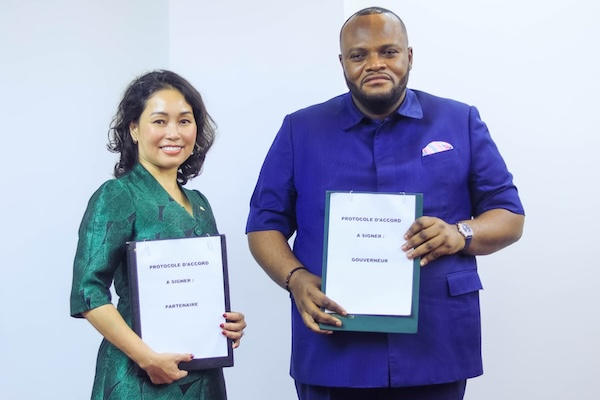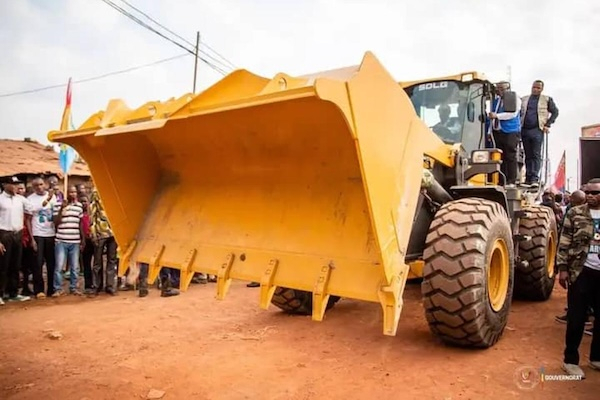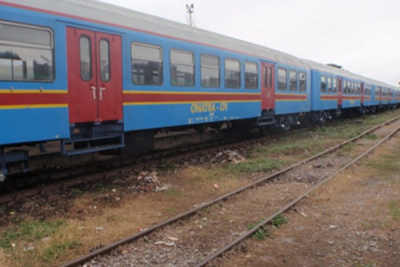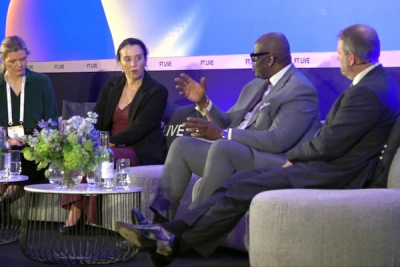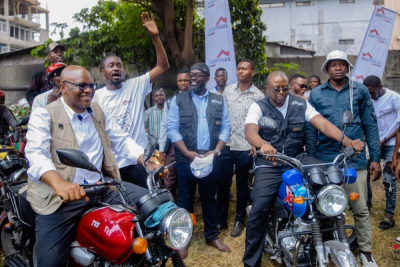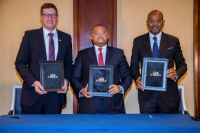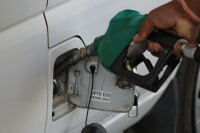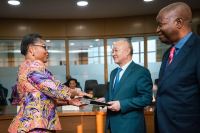
News (571)
Vietnamese conglomerate Vingroup has revealed new details about its plans in the Democratic Republic of Congo (DRC). On October 25, 2025, the company signed a memorandum of understanding with the city-province of Kinshasa to develop an urban project covering about 6,300 hectares, land that will be provided “free of charge” by the city.
According to the group’s announcement, “the project is located between the southern bank of the Congo River and the northern area of N’djili International Airport, a strategic site for the city’s expansion plan.” It aims to create a “new modern urban center” that will become a tourist destination and a symbol of Kinshasa’s progress.
The development will include residential zones, villas, apartments, hospitals, schools, shopping centers, hotels, leisure complexes, and an administrative district for ministries and government agencies.
The Vingroup project will be built in the Maluku commune, which already hosts the ongoing expansion program of the city of Kinshasa. Its content and objectives appear consistent with this larger program, which plans a new city covering 43,000 hectares about 60 kilometers from the urban center, suggesting that the Vingroup project could become one of its components.
However, the Strategic Supervision Committee for the Kinshasa City Expansion Project (CSSPEVK) is not a signatory to the October 25 memorandum, raising potential coordination and alignment challenges between the two initiatives.
Focus on clean mobility
In addition to real estate, the memorandum includes a green mobility program for Kinshasa. Through its subsidiary VinFast, founded in 2017 and specializing in electric vehicles, Vingroup plans to progressively replace about 300,000 combustion vehicles with electric ones and deploy electric buses and taxis operated via its Green and Smart Mobility (GSM) solution, already active in Vietnam.
On its official website, VinFast lists electric vehicles priced between $10,800 and $59,900, marketed in Germany, Canada, the United States, and several Asian countries.
The provincial government is expected to provide sites for installing charging infrastructure. The green mobility project is expected to cut greenhouse gas emissions and improve air quality in the capital. As of October 15, 2025, Swiss firm IQAir, which monitors air quality, ranked Kinshasa among the world’s most polluted cities, with air quality considered unhealthy.
The signing of the memorandum with Kinshasa came three days after a meeting between Vingroup Vice Chairwoman Lê Thị Thu Thủy and Prime Minister Judith Suminwa Tuluka.
During the meeting, the conglomerate said it had completed the exploratory phase of its projects in the DRC, conducted an initial assessment, and was ready to move into the contractual phase under public-private partnerships. The timeline for the final agreement and the start of the urban project’s implementation has not yet been disclosed.
Grace Nkuanga Bilolo, governor of Kongo-Central province in the Democratic Republic of Congo, launched a road rehabilitation project on Oct. 25, 2025, aimed at improving the transport of farm goods to markets.
The project, which began in Kinzau Nvuete in Seke-Banza territory, covers 550 kilometers of rural feeder roads. The work will be carried out in stages, with the first phase focusing on 230 kilometers of priority routes over nine months.
The first phase, financed by the Agency for the Management of Toll and Weighing Rights (AGDP), will cost 3.85 billion Congolese francs (about $1.6 million), or roughly $7,000 per kilometer.
The launch phase includes the Kinzau-Mvuete, Seke-Banza, Mbatassiala, and Lombo-Fuese-Kilukweta sections, located in the Kasangulu and Mbanza-Ngungu territories. The Kongo-Central Public Works Agency will carry out the work.
Governor Bilolo unveiled new civil engineering equipment purchased with provincial funds to support the project. He said the initiative is part of a provincial program to better connect rural areas, aiming to ease the sale of farm produce and improve living standards in local communities.
The governor’s announcement follows a statement by former Rural Development Minister Muhindo Nzangi Butondo in October 2024, outlining a government plan to build and rehabilitate 11,000 kilometers of agricultural feeder roads across the DRC. It was not immediately clear whether the Kongo-Central project is part of that national initiative.
Ronsard Luabeya
The Democratic Republic of Congo (DRC) has launched an international call for partners to build a domestic train assembly and manufacturing plant.
The document, signed on Oct. 17, 2025, by Transport Minister Jean-Pierre Bemba, seeks private partners to set up assembly units capable of producing dozens of locomotives and wagons each year. The project also calls for training and technology transfer to local engineers and technicians.
Planned as a 25- to 30-year public-private partnership (PPP), the initiative includes maintenance facilities, spare parts production, and vocational training.
Two sites are under consideration: Matadi, the country’s main Atlantic port, and Kalemie, a key railway junction in Tanganyika province.
The project marks a step toward developing a local railway industry in a country that relies heavily on imported rolling stock. While the government supports the plan, it faces major structural and financial hurdles.
Macroeconomic risks such as exchange-rate volatility, payment delays, and regulatory uncertainty could deter investors. Continued dependence on imported components also exposes the project to high logistical and financial risks.
Expected productivity gains could be constrained by a shortage of skilled labor, the absence of local subcontractors and integrated logistics, and persistent bottlenecks in energy, transport, and digital infrastructure.
By comparison, South Africa and Egypt built their railway industries only after decades of investment in technical training and industrial subcontracting.
According to the call document, the DRC has over 5,000 kilometers of railway lines, much of which is underused or non-operational, limiting the market’s current potential. The government, however, has begun rehabilitating national and regional rail corridors, including the Lobito Corridor linking Angola, Zambia, and the DRC, and the Tanganyika Corridor to Tanzania.
In September 2025, the government relaunched the 366-kilometer Kinshasa-Matadi line, reconnecting the capital with its main seaport and adding new rolling stock. The line is expected to be extended to the Banana deep-water port, now under construction, to strengthen both domestic and international trade.
If these projects succeed, they could ease mobility constraints in a country where roads and river transport remain overburdened by degraded infrastructure, congestion, outdated vessels, unmarked waterways, and frequent accidents that all continue to raise logistics costs and weaken economic competitiveness.
Pierre Mukoko
Chinese miner CMOC Group Ltd produced 87,974 tons of cobalt in the Democratic Republic of Congo (DRC) between January and September 2025, up 3% from the same period a year earlier, the company said in an operational report on Oct. 24.
The combined output from its Kisanfu and Tenke Fungurume mines keeps the company on track to meet its 2025 target of between 100,000 and 120,000 tons, compared with 114,200 tons in 2024.
Most of this year’s production, however, cannot be exported. The DRC , the world’s largest cobalt producer , imposed an export embargo on Feb. 21, 2025, later replaced on Oct. 16 by a quota system that limits CMOC to shipping 6,500 tons in the final quarter of the year.
For 2026, the company will be allowed to export 31,200 tons, based on December 2025’s authorized volume being maintained each month, unless regulations are breached. Over the two-year period, CMOC’s cumulative exports will be capped at 37,700 tons, less than half its output for the first nine months of 2025. Executives have described the situation as “barely tolerable.”
The quota regime is expected to remain in place until at least 2027. A total of 18,125 tons was approved for 2025, and the combined authorized export volume is projected to reach 96,600 tons for 2026 and 2027. The strategic minerals regulator ARECOMS may adjust these quotas depending on market conditions.
Kinshasa hopes the new rules will lift cobalt prices and encourage miners to invest in local refining and value-added production. Unofficial reports suggest the government is targeting a floor price of $60,000 per tonne, about triple the level recorded in February 2025, when the embargo took effect.
Cobalt currently trades at around $45,000 per tonne on the London Metal Exchange. Prices are expected to rise as the DRC, which accounted for nearly 75% of global supply in 2024, curbs exports. Global demand is forecast to increase by 4% in 2025 and 6% in 2026, according to the Cobalt Institute.
Pierre Mukoko
UK Export Finance (UKEF), the United Kingdom’s export credit agency, has announced a £500 million ($660 million) guarantee facility to support British businesses investing in the Democratic Republic of Congo (DRC).
The announcement came during the Financial Times Africa Summit 2025, held in London on Oct. 21–22 and attended by DRC Mines Minister Louis Kabamba Watum.
During the summit, Watum took part in a business meeting organized by the DRC–UK Chamber of Commerce, where discussions focused on boosting investment in the mining and energy sectors.
According to the DRC’s Ministry of Mines, UKEF’s guarantee facility aims to promote and protect British investment in the Congolese market. The ministry said the initiative forms part of the broader economic partnership between London and Kinshasa.
A delegation of British investors is expected to visit Kinshasa in January 2026 to explore specific investment opportunities.
RL
EquityBCDC has launched the Libanga account, a new banking service tailored to informal sector workers in the Democratic Republic of Congo (DRC), including motorcycle taxi drivers, farmers, small traders, domestic workers, refugees, and internally displaced persons. The product was unveiled on October 23, 2025.
Account opening conditions have been simplified: applicants must reside in the DRC, present valid identification (such as a voter card, passport, driver’s license, refugee card, or loss declaration), have a monthly income below $300, make an initial deposit of 2,300 Congolese francs (FC), and maintain a minimum monthly deposit of 700 FC.
To attract this largely unbanked segment, the bank made several services free of charge, including local debit cards and internal transfers and withdrawals.
The Libanga account also features a social protection component. In partnership with Activa Assurance RDC, account holders can access a health and funeral insurance plan for a $1 monthly contribution, covering primary medical care at Afia Health Center and a $100 funeral benefit. The bank describes the initiative as a response to the essential protection and income security needs of its new clientele.
EquityBCDC said the product aligns with its goal of bringing formal banking to nearly 30 million Congolese by 2030, reflecting its broader strategy to expand financial inclusion and support the gradual formalization of the national economy.
As of October 2024, EquityBCDC — 85.67% owned by Kenya’s Equity Holdings Group — had over 1.8 million clients and total assets of $4.4 billion.
Shelter Afrique plans to open a $10 million credit facility for CRDB Bank to support affordable housing projects in the Democratic Republic of Congo (DRC). The pan-African housing finance institution formalized the plan by signing a memorandum of understanding with the Tanzanian commercial bank on the sidelines of the World Bank and IMF annual meetings held in Washington, D.C., from October 13 to 17, 2025.
The preliminary agreement also includes advisory support from Shelter Afrique to help CRDB Bank’s housing finance team better address the full housing value chain.
According to Shelter Afrique CEO Thierno-Habib Hann, the initiative reflects both institutions’ shared commitment to expanding access to affordable housing while promoting regional trade in building materials. It also aligns with a 2023 memorandum signed between Shelter Afrique and the DRC’s Ministry of Urban Planning and Housing, which aimed to co-finance housing projects, arrange additional funding, provide technical assistance, and help the government assess the national real estate market.
Initially, the collaboration will focus on CRDB Bank’s operations in the DRC, with potential future expansion to Tanzania and Burundi. The timeline for the final agreement and implementation of the facility has not yet been disclosed.
In 2023, UN-Habitat estimated the DRC’s housing deficit at 4 million units. With over 15 million residents, Kinshasa alone accounts for 54.4% of the housing need. Meeting this demand would require building 143,092 homes annually in the capital and 265,000 nationwide.
Funding for the housing sector remains scarce. A 2022 IFC study found that total mortgage credit in the DRC stood at only $30 million, representing less than 1% of all loans in the country. Through its partnership with Shelter Afrique, CRDB Bank aims to expand into this market.
Operating in the DRC since 2023, CRDB Bank is still in its establishment phase, with branches in Kinshasa and Lubumbashi. This investment phase has weighed on its results: according to its 2024 annual report, the bank posted a loss of 6.6 billion Tanzanian shillings ($2.5 million) during its second year of operations in the country.
The government of the Democratic Republic of Congo (DRC) is pushing to ensure that the recent appreciation of the Congolese Franc (FC) translates into concrete benefits for households. Following an economic briefing on Oct. 22, 2025, led by President Félix Antoine Tshisekedi Tshilombo, Minister of National Economy Daniel Mukoko Samba announced an imminent drop in fuel prices.
The meeting at the Presidency was convened to examine the FC’s recent appreciation against other currencies and ensure that households experience an actual increase in purchasing power. Minister Mukoko stated that concrete measures would be taken to ensure price reductions reflect this monetary shift.
The announcement comes two weeks after a fuel price cut was implemented in the country’s western zone, which includes provinces like Kinshasa and Kongo-Central. Gasoline prices fell from 2,990 FC to 2,690 FC per liter, and diesel dropped from 2,980 FC to 2,680 FC. However, for Congolese whose income or savings are denominated in U.S. dollars, the prices effectively increased in dollar terms: 2,990 FC was equivalent to approximately $1.03, while 2,690 FC now represents at least $1.44.
The National Movement of Injured Consumers (MNCL) noted this trend, illustrating the shift in an Oct. 14 statement: the price of a beer remained at 4,000 FC, effectively rising from $1.37 to $2.10, while a carton of chicken dropped from 108,000 FC to 80,000 FC, which is an increase from $38.57 to $40.
The MNCL also highlighted that the situation is compounded by exchange rate speculation practiced by some currency traders and Mobile Money agents. The movement noted that while the Central Bank of Congo communicates an official rate of 2,300 FC per dollar, many traders are changing one dollar for 1,900 FC, 1,800 FC, or even 1,700 FC. This distortion further erodes the purchasing power of those receiving dollar-denominated income.
In response, the government intends to fight exchange rate speculation and compel merchants to lower prices to offset the dollar-denominated purchasing power loss caused by the FC's appreciation. For fuel, the Minister announced a meeting with oil companies on Oct. 31, 2025. The day before the presidential meeting, he had launched economic control missions aimed at stabilizing the domestic market, verifying regulatory compliance, ensuring price transparency, and assessing the actual impact of the franc's appreciation on basic necessities.
However, this push is generating concern among several economic operators who fear being forced to sell at a loss, citing the inventory effect. This mainly affects importers and producers who rely on dollar-denominated inputs and imported machinery.
Supermarkets, importers, and distributors do not replenish their stock daily. They often import large quantities financed in dollars. If they procured goods at an exchange rate of 2,800 FC per dollar, their costs and sales prices were set accordingly. If the rate then drops to 2,600 FC per dollar a few weeks later, their existing inventory remains valued at the old rate. Consequently, they cannot immediately pass on the appreciation of the Congolese Franc without reducing profit margins or selling at a loss.
Oil marketers are an exception to this dynamic, as the government compensates them for foreign exchange losses.
Timothée Manoke
The planned China-Congo Industrial City is now estimated to cost $12 billion, up from previous projections. The new figure was announced on Oct. 23, 2025, during a ceremony in Kinshasa chaired by Prime Minister Judith Suminwa, which also saw the signing of a collaboration agreement between the Democratic Republic of Congo (DRC) and the Sino-Congo Special Economic Development Zone (SCSZ) consortium.
The industrial city is part of the broader Kinshasa Urban Expansion Project, a major $50 billion development plan to build a new city spanning 43,000 hectares in Maluku, about 60 kilometers east of central Kinshasa.
Originally expected to cover 7,500 hectares, the Industrial City—which could generate over 150,000 direct and indirect jobs—will now see that area apply only to phase one, according to the Prime Minister’s office and the Strategic Oversight Committee for the Kinshasa Urban Expansion Project (CSSPEVK). Details on a second phase have not yet been released.
Official information indicates that the first phase will include eight industrial parks covering the construction materials, agri-food, textiles, chemical and metallurgical, forest products, electronics and high-tech, mechanical and electrical manufacturing, and recycling sectors.
The parks will host about 1,200 factories over 5,000 hectares, along with a 2,000-hectare commercial district and a 500-hectare residential zone for workers. The cost of this first phase was initially estimated at $8 billion, according to the Belgian daily L’Écho. The terms of the agreement with SCSZ has not been made public, but officials describe it as “the second of its kind after the Sicomines deal.”
Signed in 2008, the Sicomines agreement linked the DRC with a Chinese consortium comprising Crec, Sinohydro, and Zhejiang Huayou in a minerals-for-infrastructure exchange, often dubbed the “contract of the century.” The new agreement involves a different Chinese consortium, led by China State Construction Engineering.
If the SCSZ deal follows the same model as Sicomines, analysts warn it could face similar governance and transparency issues. In July 2024, the International Monetary Fund (IMF) urged the DRC to strengthen transparency and accountability mechanisms in managing the Sicomines convention.
Whether the DRC has learned from that experience may become clearer in the coming weeks. The signing of the SCSZ convention nonetheless marks a decisive step toward implementing the China–Congo Industrial City project.
Pierre Mukoko
Democratic Republic of Congo Prime Minister Judith Suminwa Tuluka met with a delegation from the Vietnamese conglomerate Vingroup on Oct. 23, 2025, in Kinshasa. The meeting, led by Vingroup Vice Chair Lê Thị Thu Thủy, aimed to explore a public-private partnership to support key initiatives under the government’s action plan.
According to a statement from the Prime Minister’s office, the initial assessment of priority sectors has been completed. Vingroup expressed readiness to invest in five main areas: agriculture, health, education, real estate, and infrastructure.
Although no concrete details—such as project amounts, timelines, or locations—have been disclosed, both parties confirmed that the exploratory phase is over and that they are ready to enter contract negotiations.
Founded in 1993 in Ukraine as Technocom Corporation, Vingroup Joint Stock Company (Vingroup JSC) launched its activities in Vietnam in the early 2000s under two brands: Vincom (real estate and retail) and Vinpearl (tourism and hospitality).
These entities merged in January 2012 to form Vingroup JSC. Today, Vingroup is a diversified conglomerate operating across five main divisions: industry and technology, real estate and services, infrastructure, green energy, and social initiatives.
Boaz Kabeya
More...
MSSZ, a subsidiary of Ivorian group SCHIBA, is expected to win a contract for the construction of a roughly 220-kilometer road segment connecting Kabinda in Lomami province to Ngandajika in Kasai Oriental province, the company said.
“Since the construction company MSSZ proposed to work with us, the Congolese population can now hope to see concrete achievements here, notably the construction of the road linking Kabinda to Ngandajika, as well as other work concerning the urban road network of Kinshasa,” Public Works and Infrastructure Minister John Banza said on Oct. 21, 2025, as quoted by the Agence Congolaise de Presse (ACP).
The state-owned news agency reported that the minister made the statement upon his return from Abidjan, Côte d’Ivoire where he met with the group's leaders and visited some of its active construction sites.
Prior to the visit, a SCHIBA delegation, led by Chairman and CEO Soro Nidjabedjan, was received in Kinshasa by Minister Banza. During that meeting, SCHIBA expressed interest in road and energy projects in the Democratic Republic of Congo, highlighting its experience having completed over 1,200 kilometers of roads in Côte d’Ivoire.
Efforts are escalating to boost economic exchange between Côte d’Ivoire and the DRC. The matter was central to an audience held on Oct. 15 between the National President of the Federation of Enterprises of Congo (FEC), Robert Malumba Kalombo, and the Ambassador of Côte d’Ivoire to the DRC, Xavier Zabvi.
During their talks, the two officials acknowledged that, despite strong cultural ties, economic exchanges between the two nations remain limited, even with numerous existing opportunities, particularly under the African Continental Free Trade Area (AfCFTA). Both parties agreed to organize a bilateral economic forum in 2026.
Boaz Kabeya
The supply of petroleum products in Kinshasa is expected to return to normal on Oct. 23, after two days of disruption caused by vandalism, the Hydrocarbons Ministry said in a statement on Oct. 22, 2025.
The disruption began after an act of sabotage during the night of Oct. 18-19 targeting pipeline 66, operated by Société des entreprises pétrolières du Congo (SEP Congo). Unidentified individuals drilled into the pipeline in the Masina district, near Ndjili CECOMAF, to illegally siphon fuel bound for the Kinshasa depot.
The sabotage led to a temporary shutdown of pumping operations, halting deliveries and causing long queues at several gas stations across the capital.
The ministry said technical teams from SEP Congo have since sealed the leaks and restored the pipeline to service. In an Oct. 21 letter to the Hydrocarbons Minister, the company confirmed that transport and distribution operations were gradually resuming.
SEP Congo called for stronger security measures for its pipelines, including public awareness campaigns and tighter surveillance. The Hydrocarbons Ministry urged residents to remain vigilant and help protect this critical infrastructure, which is essential to the capital’s fuel supply.
Ronsard Luabeya
The DRC army's aviation carried out new strikes on the Twangiza Mining gold processing plant in Mwenga territory, South Kivu, during the night of Oct. 22-23, 2025, according to local media reports. The site, located about 40 kilometers southwest of Bukavu, has been occupied by the M23 rebel group since early May 2025, forcing the company to declare force majeure.
Twangiza Mining told Reuters that it has lost over 100 kilograms of gold per month since the takeover, in addition to equipment and material valued at an estimated $5 million. The company did not specify whether the damage was due to theft, destruction, or abandonment. The approximately 500 kilograms of gold lost to date represents about $70 million at current market prices, bringing the total estimated loss to around $75 million.
The strikes overnight into Oct. 23 were the third aerial operation against the facilities held by the rebels. Previous attacks a week earlier had already damaged the electrical infrastructure supplying the plant. Local sources indicate the latest shelling targeted fuel tanks and backup generators, including those already out of service, in a bid to hinder the M23's alleged illegal gold processing activities.
Sources familiar with the operation said the Twangiza Mining plant has a production capacity of over 300 kilograms of gold per month. However, the company has not appeared in official industrial production statistics since 2021. This prolonged absence raises questions now that the firm claims to have lost over 100 kilograms of gold monthly since the site fell under rebel control.
In 2020, Canadian company Banro, which had operated the Twangiza gold mine since 2012, announced it had sold its stake to minority shareholder Baiyin International Investments for a symbolic franc. Local media reported that Baiyin subsequently transferred the site to the Chinese company Ultrawell.
Timothée Manoke
Democratic Republic of Congo (DRC) Finance Minister Doudou Fwamba met with a delegation from JPMorgan Chase & Co. on Oct. 17, 2025, during the IMF-World Bank Annual Meetings. According to the Ministry, the talks are part of efforts to strengthen the country’s international credibility and raise its profile in capital markets.
Fwamba is preparing the DRC’s first Eurobond issue, a deal expected before June 30, 2026, to raise $1.5 billion. JPMorgan, which has advised several African states including Kenya, Nigeria, Senegal, and Angola, specializes in structuring sovereign bond transactions.
At the meeting, Fwamba highlighted macroeconomic stability and ongoing reforms to improve transparency in public financial management. “We want investors to see the DRC as a reliable partner committed to sustainable development,” he said, citing efforts to fight corruption and strengthen public finances.
JPMorgan welcomed progress on the business climate and expressed interest in further engagement with Congolese authorities. The bank plans a working visit to Kinshasa in the coming weeks.
The DRC’s inflation has fallen to 7.8% from 15.1% a year earlier, while the Congolese franc has gained about 23% on the official market, trading near 2,200 per dollar. The country’s public debt stands at a modest 22.5% of GDP, with speculative ratings of B- (S&P) and B3 (Moody’s), both stable.
However, analysts say the DRC’s continued inclusion on the FATF gray list remains a key obstacle, keeping the country tagged as high-risk for money laundering and terrorist financing. Despite efforts to comply, the FATF said in June that “work remains to be done.”
Ronsard Luabeya






